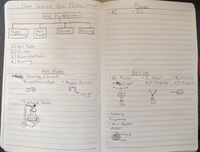No edit summary |
|||
| Line 16: | Line 16: | ||
==Literature Review== | ==Literature Review== | ||
[[https://pubs.acs.org/doi/abs/10.1021/ed500153r | [[https://pubs.acs.org/doi/abs/10.1021/ed500153r <big>Low-Cost Magnetic Stirrer from Recycled Computer Parts with Optional Hot Plate</big>]]<br> | ||
'''Armando M. Guidote, Giselle Mae M. Pacot, and Paul M. Cabacungan, "Low-Cost Magnetic Stirrer from Recycled Computer Parts with Optional Hot Plate",Journal of Chemical Education 2015 92 (1), 102-105, DOI: 10.1021/ed500153r'''<br> | '''Armando M. Guidote, Giselle Mae M. Pacot, and Paul M. Cabacungan, "Low-Cost Magnetic Stirrer from Recycled Computer Parts with Optional Hot Plate",Journal of Chemical Education 2015 92 (1), 102-105, DOI: 10.1021/ed500153r'''<br> | ||
'''Abstract''' Magnetic stirrers and hot plates are key components of science laboratories. However, these are not readily available in many developing countries due to their high cost. This article describes the design of a low-cost magnetic stirrer with hot plate from recycled materials. Some of the materials used are neodymium magnets and CPU fans from discarded computers and recycled electrical components from old circuit boards. This prototype was compared with a commercial magnetic stirrer with hot plate. It was noted that high temperatures were reached at similar rates, and the stirring speed was also comparable between the two. With this prototype, which costs 80% less than commercials ones, magnetic stirrers with hot plate can be readily available to enhance teaching and learning in science laboratories that need them most. | '''Abstract''' Magnetic stirrers and hot plates are key components of science laboratories. However, these are not readily available in many developing countries due to their high cost. This article describes the design of a low-cost magnetic stirrer with hot plate from recycled materials. Some of the materials used are neodymium magnets and CPU fans from discarded computers and recycled electrical components from old circuit boards. This prototype was compared with a commercial magnetic stirrer with hot plate. It was noted that high temperatures were reached at similar rates, and the stirring speed was also comparable between the two. With this prototype, which costs 80% less than commercials ones, magnetic stirrers with hot plate can be readily available to enhance teaching and learning in science laboratories that need them most. | ||
==Construction== | ==Construction== | ||
Revision as of 19:13, 14 September 2020
Lit review for open hardware project on XXXX
- Make sure you add [[Category:MSE5621-2020]]
- Make sure it has not been done before - e.g. Google "open source XXXX", "how to make a XXXX" "DIY XXXX"
- Make sure it is not already in the literature Google Scholar search "fabrication of XXXX" "Assembly of XXXX" instrumentation + XXXXX, etc.
- Do a complete market analysis for similar products - send requests for quotes now!
- Find the literature explaining how XXXX works
- Look for review articles on instrumentation
- Do a short search for applications of XXXX
List of search terms
- hot plate magnetic stirrer
Literature Review
[Low-Cost Magnetic Stirrer from Recycled Computer Parts with Optional Hot Plate]
Armando M. Guidote, Giselle Mae M. Pacot, and Paul M. Cabacungan, "Low-Cost Magnetic Stirrer from Recycled Computer Parts with Optional Hot Plate",Journal of Chemical Education 2015 92 (1), 102-105, DOI: 10.1021/ed500153r
Abstract Magnetic stirrers and hot plates are key components of science laboratories. However, these are not readily available in many developing countries due to their high cost. This article describes the design of a low-cost magnetic stirrer with hot plate from recycled materials. Some of the materials used are neodymium magnets and CPU fans from discarded computers and recycled electrical components from old circuit boards. This prototype was compared with a commercial magnetic stirrer with hot plate. It was noted that high temperatures were reached at similar rates, and the stirring speed was also comparable between the two. With this prototype, which costs 80% less than commercials ones, magnetic stirrers with hot plate can be readily available to enhance teaching and learning in science laboratories that need them most.
Construction
Parts

Heater
o Heating Element - Major area of failure?) o Plate Cover
Stirring Unit
o Motor o Magnet -Electromagnet -Solenoids programmed like a stepper motor -cover magnet in aluminum foil to avoid damage d/t heating? o Stir Bar o (Rotarty encoder for speed sensor?) o Solid-State stirrer? o Outsource stirrer?
Housing
o Temperature probe stand/holder? o Temperature probe? - RTD - Type K thermocouple? o Digital Display? o
Power/Electronics
o AC Power o DC Power
References
- Thermocouple vs RTD(Temperature Sensors)
o https://blog.lesman.com/2012/02/09/which-temperature-sensor-do-i-need-rtd-or-thermocouple/
- Open Source DIY Mag Stirrer
o https://www.youtube.com/watch?v=Kn-eLq7-Fbw&feature=youtu.be o https://www.sciencemadness.org/whisper/viewthread.php?tid=71217
-1962 Hot Plate/Stirrer Patent
o https://patents.google.com/patent/US3028476A/en

